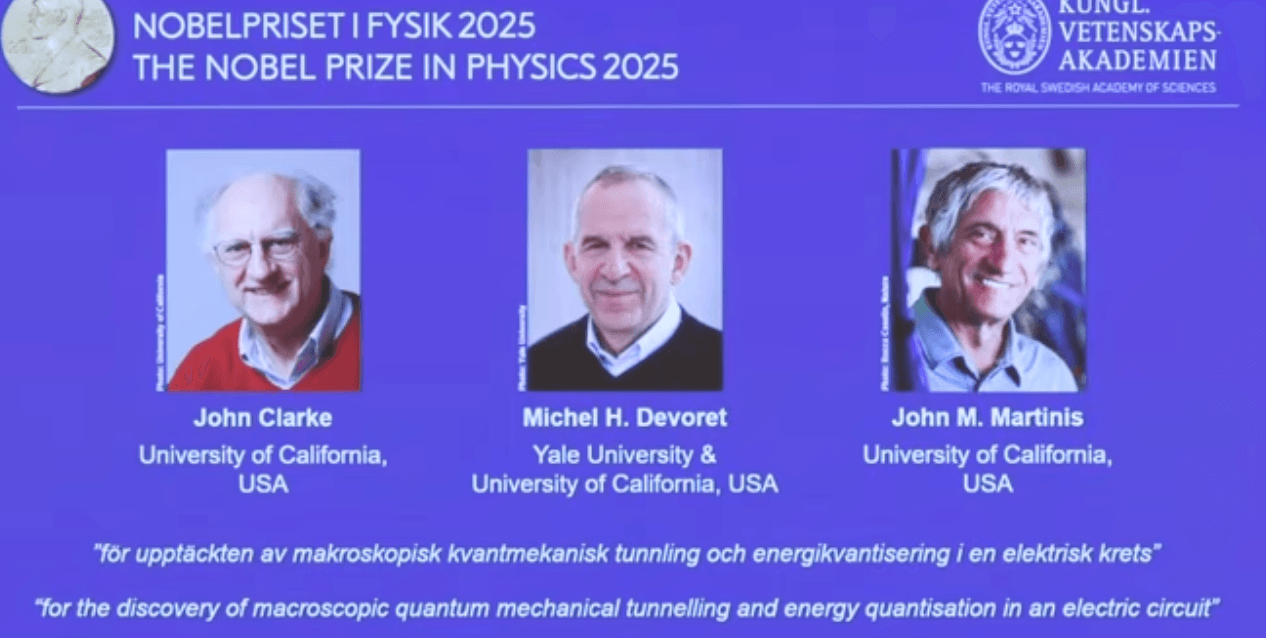Nobel Prize in Physics 2025 Awarded for Groundbreaking Work in Quantum Circuits
The Royal Swedish Academy of Sciences has awarded the 2025 Nobel Prize in Physics to three pioneering scientists whose work has bridged the gap between the bizarre quantum world and observable electrical circuits, laying the foundation for the quantum computing revolution.
Meet the 2025 Nobel Laureates in Physics
The prestigious award is shared equally by three American scientists for their fundamental contributions to quantum physics.
| Laureate | Affiliation(s) |
|---|---|
| John Clarke | University of California, USA |
| Michel H. Devoret | Yale University & University of California, USA |
| John M. Martinis | University of California, USA |
Official Citation: The prize was awarded “for the discovery of macroscopic quantum mechanical tunnelling and energy quantisation in an electric circuit.”
Decoding the Groundbreaking Discovery
The work of Clarke, Devoret, and Martinis demonstrated that the strange rules of quantum mechanics, typically seen only at the atomic and subatomic levels, can be observed and controlled in specially designed electrical circuits. This was a monumental step in making quantum phenomena tangible and engineerable.
1. Macroscopic Quantum Tunnelling
In the classical world, an object cannot pass through a solid barrier without having enough energy to go over it. However, in the quantum world, particles can “tunnel” through energy barriers they shouldn’t be able to cross. The laureates proved that this bizarre effect isn’t just limited to single particles; it can happen on a “macroscopic” scale involving billions of atoms acting in unison within a superconducting circuit. This was a stunning confirmation of quantum theory on a larger scale.
2. Energy Quantisation in an Electric Circuit
Another core principle of quantum mechanics is that energy is “quantised,” meaning it exists in discrete, step-like levels rather than as a continuous spectrum. Think of it like a staircase rather than a ramp. The laureates designed superconducting circuits where the energy levels were clearly defined and separated. By doing so, they essentially created artificial atoms whose quantum states (like energy levels) could be precisely controlled and measured. These circuits are now known as superconducting qubits, the fundamental building blocks of many modern quantum computers.
Impact and Future Applications: The Dawn of Quantum Computing
The discoveries by these three laureates are not just theoretical curiosities; they are the bedrock upon which the field of quantum technology is built.
- Quantum Computing: Their work on creating and controlling quantum states in circuits (qubits) is fundamental to building quantum computers. John Martinis, for instance, led the Google team that first demonstrated “quantum supremacy,” where a quantum computer performed a calculation impossible for even the most powerful classical supercomputers.
- Precision Measurement: The ability to create such sensitive circuits has led to the development of ultra-precise sensors. John Clarke is a leading figure in the development of SQUIDs (Superconducting Quantum Interference Devices), which can detect magnetic fields millions of times weaker than those of the human brain.
- Fundamental Physics Research: These “artificial atoms” provide a unique platform for physicists to test the fundamental laws of quantum mechanics in a controlled environment, pushing the boundaries of our understanding of the universe.
You can Check More Details Here www.nobelprize.org
Frequently Asked Questions (FAQs)
Q1: Who won the Nobel Prize in Physics for 2025?
The Nobel Prize in Physics 2025 was jointly awarded to three scientists: John Clarke (University of California), Michel H. Devoret (Yale University & University of California), and John M. Martinis (University of California).
Q2: What discovery were they awarded for?
They were awarded for the discovery of two key quantum phenomena in man-made electrical circuits: macroscopic quantum mechanical tunnelling and energy quantisation. Essentially, they showed that the strange rules of the quantum world can be harnessed in circuits we can build and control.
Q3: Why is this research so important?
This research is crucial because it forms the foundation for practical quantum technologies, most notably quantum computing. By creating controllable quantum systems (qubits), their work has enabled the development of computers with the potential to solve problems far beyond the reach of classical computers.
Q4: What is a “qubit”?
A qubit, or quantum bit, is the basic unit of quantum information. Unlike a classical bit, which can be either a 0 or a 1, a qubit can exist as a 0, a 1, or both at the same time (a state known as superposition). The circuits designed by the laureates act as robust, controllable qubits.
